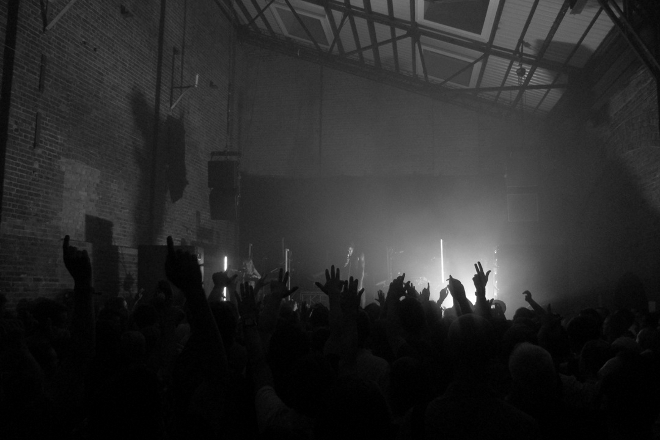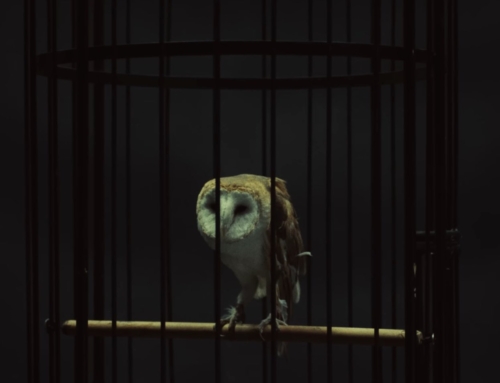The warehouse party is dead – long live the “warehouse party.”
A cornerstone of dance music history, a warehouse party has come to be defined as any illegal event – no permit or license – held inside a former industrial location. In some cases, the definition has been stretched to encompass any type of word-of-mouth party location: the forest, in a field, or anything qualifying as a “free” party.
These occurred on both sides of the Atlantic, often catering to working-class kids. In the U.K., the dying textile industry’s factories and mills were easily taken over by DJs and musicians associated with the Manchester music scene. In the U.S., warehouse parties, really, cropped up around any dance music epicenter: Detroit, Chicago, and New York.
Yet, stricter licensing laws over the course of the 1990s essentially killed the warehouse party in the purest form. That’s not to say dance music died with it, however. In Europe, promoters and DJs associated with massive illegal parties eventually got behind the country’s superclubs, like Ministry of Sound.
In the U.S., the results are mixed. Smaller cities where you could once find warehouse parties, like Hartford, Conn., have gone the way of bottle service clubs. In places like New York, it’s said that the restrictions placed on dancing in non-music venues eventually pushed the warehouse and underground music scene over to Brooklyn in the early 2000s. Instead, you’ve got a seeming-dichotomy between Manhattan’s nightclubs – big-name, mainstream DJs, expensive bottle service, and dress codes – and the organized “warehouse parties” in Brooklyn – casual, a hipster crowd, and underground talent behind the sounds.
What appears like a split between authenticity and everything that gives dance music a bad name is more of a blurred, gray area. The concept of a “warehouse party,” essentially, pays tribute to the origins – it’s in an older, out-of-use industrial building – and the DJ’s star power plays second fiddle to the “vibe” created.
On the other hand, the modern “warehouse party” has far more in common with dance music’s club culture than it would like to admit. Events get advertising space – through an online event listing or social media – and the promoters actually secure licensing to use the venue. And the warehouse, really, has become more like a concert venue. Take Brooklyn’s The Lab: Yes, it’s rumored that Frankie Bones held a few raves there, but now, the former parking garage turned strip club has themed nights – dance, hip-hop, and reggae – and has even hosted Puff Daddy’s “Biggie Day” event.
And following this concept, what’s being called a “warehouse party” has actually gotten kind of gimmicky. Like, desperate-to-get-you-to-attend gimmicky. We accept the occasional White Party or college night of hot girls and reduced priced drinks at standard nightclubs; after all, it brings out the customers and their money. And we don’t bat an eye when, across the river, Pacha NYC advertises its “S&M Party,” “No Pants Party,” or the “World’s Largest Paint Party.”
Underground dance music always pretends to be better than that. It claims to be built on the actual foundation of dance music, after all, while “mainstream” is an off-shoot that misinterprets dance music’s roots and has gone too far and too wrong.
But it seems that the new concept of a “warehouse party” has gotten stale, even with its core audience. The grimy location and underground talent aren’t enough. Instead, if you’re on a mailing list, you get notified about a “secret” location in which a big-name DJ will be playing – Nicole Moudaber or even, yes, Skrillex – and have to buy a ticket before you know where you’re going.
Or, more recently, I got a tip about Hot Since 82’s Taken concept, which, really, is the next level up. Not only is the location not disclosed, but you’re “taken” from a location in New York, blind-folded, and then bused to a second location – where you won’t know where you are.
On one hand, Hot Since 82’s been trying to show just how authentically old-school he is. “I make real deep house!” his music seems to say. “And I remixed Black Box! How many EDM fans even know of Black Box?” But seeming old school and pandering to crowds pining for exclusivity that doesn’t involve five-inch heels have created an embarrassing amalgamation: a club night in a warehouse that tries to pretend it’s not a club night but is almost exactly promoted and designed like one, to a T.
So, why has this happened?
1. The Lure of Doing Something Illegal has Been Replaced
A warehouse party could be in the shoddiest place possible, but the music was good, and there was an air of secretiveness to it. You heard by word of mouth, and everyone else did, too. Much like a big portion of electronic dance music culture, it was all about subverting the norm and existing away from anything conventional or mainstream.
That’s all gone for the most part. This isn’t to say that illegal parties aren’t out there – they are, and the police continue to crackdown on them – but in spots where tight restrictions are placed on practically every venue – looking at you, Manhattan and gentrified parts of Brooklyn – pretending to have a warehouse party becomes the next best thing.
2. Underground vs. Mainstream Code Words
Mainstream music has certain connotations: huge superclubs in Las Vegas and Europe, massive dance music festivals, and big room house, among other characteristics. Bigger doesn’t always mean better when something’s grandiose yet seemingly vacuous.
So to counteract this, underground dance music (UDM) culture has its own set of code phrases. “Minimal,” “deep,” “liquid,” and “downtempo” are all acceptable, while a “warehouse” is preferable to a club.
But beyond what words you use and the sounds you hear, the schism’s not as pronounced as you think it is. EDM has its Electric Daisy Carnival. UDM has BangOn! hosting a festival inside a warehouse, with three stages, art installation, live aerial performances, carnival rides, and an inflatable slide. Similarly, Pacha does its Pier of Fear every year, while BangOn! puts on its “Warehouse of Horrors.”
3. EDM Has More Influence Than Fans Want to Admit
UDM culture complains about the bottle service customers not following the unspoken rules of the warehouse party. And while the suit and high heels should probably be tossed, EDM culture still gets through the door: people want a spectacle.
But they want it with a side of authenticity, so they can talk about how “awesome the vibe was.” So what results is the trappings of a nightclub or festival get polished up with a series of UDM-acceptable DJs – newer guys like Hot Since 82 or someone classic like DJ Pierre or even Sasha – and is placed in a warehouse-like venue. Then, voila! You’ve got a “warehouse party.”




